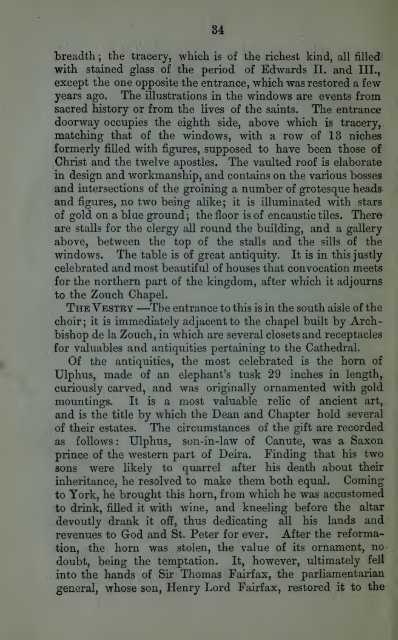practicalguideto00unse_0
Create successful ePaper yourself
Turn your PDF publications into a flip-book with our unique Google optimized e-Paper software.
34<br />
"breadth ; the tracery, which is of the richest kind, all filled<br />
with stained glass of the period of Edwards II. and III.,<br />
except the one opposite the entrance, which was restored a few<br />
years ago. The illustrations in the windows are events from<br />
sacred history or from the lives of the saints. The entrance<br />
doorway occupies the eighth side, above which is tracery,<br />
matching that of the windows, with a row of 13 niches<br />
formerly filled with figures, supposed to have been those of<br />
Christ and the twelve apostles. The vaulted roof is elaborate<br />
in design and workmanship, and contains on the various bosses<br />
and intersections of the groining a number of grotesque heads<br />
and figures, no two being alike; it is illuminated with stars<br />
of gold on a blae ground; the floor is of encaustic tiles. There<br />
are stalls for the clergy all round the building, and a gallery<br />
above, between the top of the stalls and the sills of the<br />
windows. The table is of great antiquity. It is in this justly<br />
celebrated and most beautiful of houses that convocation meets<br />
for the northern part of the kingdom, after which it adjourns<br />
to the Zouch Chapel.<br />
The Vestry —The entrance to this is in the south aisle of the<br />
choir; it is immediately adjacent to the chapel built by Archbishop<br />
de la Zouch, in which are several closets and receptacles<br />
for valuables and antiquities pertaining to the Cathedral.<br />
Of the antiquities, the most celebrated is the horn of<br />
Ulphus, made of an elephant's tusk 29 inches in length,,<br />
curiously carved, and was originally ornamented with gold<br />
mountings. It is a most valuable relic of ancient art,,<br />
and is the title by which the Dean and Chapter hold several<br />
of their estates. The circumstances of the gift are recorded<br />
as follows: Ulphus, son-in-law of Canute, was a Saxon<br />
prince of the western part of Deira. Finding that his two<br />
sons were likely to quarrel after his death about their<br />
inheritance, he resolved to make them both equal. Coming<br />
to York, he brought this horn, from which he was accustomed<br />
to drink, filled it with wine, and kneeling before the altar<br />
devoutly drank it off, thus dedicating all his lands and<br />
revenues to God and St. Peter for ever. After the reformation,<br />
the horn was stolen, the value of its ornament, no<br />
doulDt, being the temptation. It, however, ultimately fell<br />
into the hands of Sir Thomas Fairfax, the parliamentarian<br />
general, whose son, Henry Lord Fairfax, restored it to the















